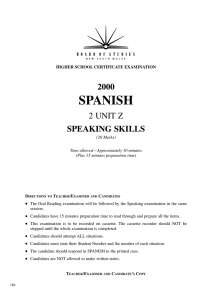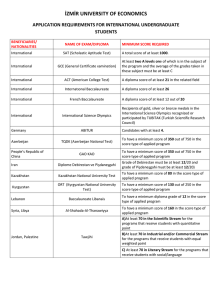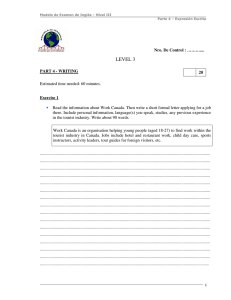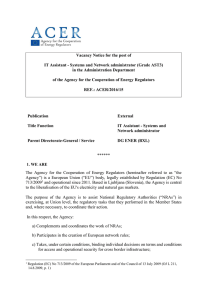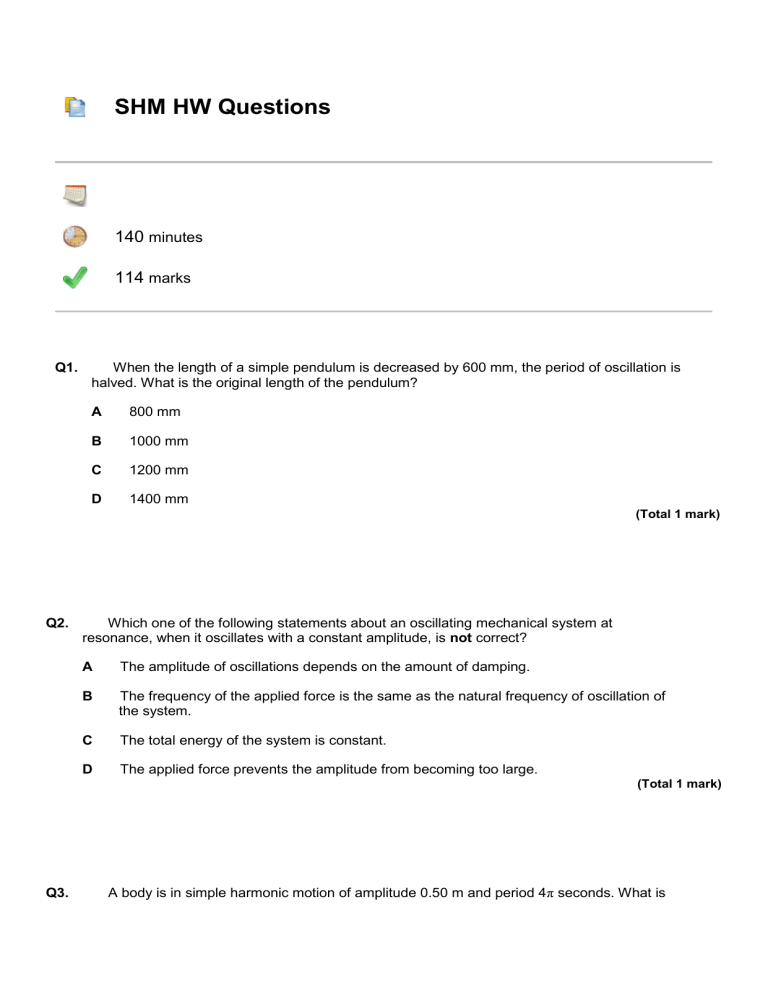
SHM HW Questions
140 minutes
114 marks
Q1.
When the length of a simple pendulum is decreased by 600 mm, the period of oscillation is
halved. What is the original length of the pendulum?
A
800 mm
B
1000 mm
C
1200 mm
D
1400 mm
(Total 1 mark)
Q2.
Which one of the following statements about an oscillating mechanical system at
resonance, when it oscillates with a constant amplitude, is not correct?
A
The amplitude of oscillations depends on the amount of damping.
B
The frequency of the applied force is the same as the natural frequency of oscillation of
the system.
C
The total energy of the system is constant.
D
The applied force prevents the amplitude from becoming too large.
(Total 1 mark)
Q3.
A body is in simple harmonic motion of amplitude 0.50 m and period 4π seconds. What is
the speed of the body when the displacement of the body is 0.30 m?
A
0.10 m s–1
B
0.15 m s–1
C
0.20 m s–1
D
0.40 m s–1
(Total 1 mark)
Q4.
Which one of the following statements concerning forced vibrations and resonance is
correct?
A
An oscillating body that is not resonating will return to its natural frequency when the
forcing vibration is removed.
B
At resonance, the displacement of the oscillating body is 180° out of phase with the
forcing vibration.
C
A pendulum with a dense bob is more heavily damped than one with a less dense bob of
the same size.
D
Resonance can only occur in mechanical systems.
(Total 1 mark)
Q5.
A mass M hangs in equilibrium on a spring. M is made to oscillate about the equilibrium
position by pulling it down 10 cm and releasing it. The time for M to travel back to the
equilibrium position for the first time is 0.50 s. Which row, A to D, in the table is correct for these
oscillations?
amplitude / cm
period / s
A
10
1.0
B
10
2.0
C
20
2.0
D
20
1.0
(Total 1 mark)
Q6.
Which one of the following gives the phase difference between the particle velocity and the
particle displacement in simple harmonic motion?
A
rad
B
rad
C
D
rad
2π rad
(Total 1 mark)
Q7.When a mass M attached to a spring X, as shown in Figure 1, is displaced downwards and
released it oscillates with time period T. An identical spring is connected in series and the same
mass M is attached, as shown in Figure 2.
What is the new time period?
Figure 2
Figure 1
A
B
C
D
(Total 1 mark)
Q8.When a mass suspended on a spring is displaced, the system oscillates with simple harmonic
motion. Which one of the following statements regarding the energy of the system isincorrect?
A
The potential energy has a minimum value when the spring is fully compressed or fully
extended.
B
The kinetic energy has a maximum value at the equilibrium position.
C
The sum of the kinetic and potential energies at any time is constant.
D
The potential energy has a maximum value when the mass is at rest.
(Total 1 mark)
Q9.A particle of mass m oscillates in a straight line with simple harmonic motion of constant
amplitude. The total energy of the particle is E. What is the total energy of another particle of
mass 2m, oscillating with simple harmonic motion of the same amplitude but double the
frequency?
A
E
B
2E
C
4E
D
8E
(Total 1 mark)
Q10.
A particle, whose equilibrium position is at Q, is set into oscillation by being displaced to P,
50 mm from Q, and then released from rest. Its subsequent motion is simple harmonic, but
subject to damping. On the first swing, the particle comes to rest momentarily at R, 45 mm from
Q.
During this first swing, the greatest value of the acceleration of the particle is when it is at
A
P.
B
Q.
C
R.
D
P and R.
(Total 1 mark)
Q11.
A particle of mass 5.0 × 10–3 kg performing simple harmonic motion of amplitude 150 mm
takes 47 s to make 50 oscillations. What is the maximum kinetic energy of the particle?
A
2.0 × 10–3 J
B
2.5 × 10–3 J
C
3.9 × 10–3 J
D
5.0 × 10–3 J
(Total 1 mark)
Q12.
A wave of frequency 5 Hz travels at 8 km s–1 through a medium. What is the phase
difference, in radians, between two points 2 km apart?
A
0
B
C
π
D
(Total 1 mark)
Q13.
Which one of the following gives the phase difference between the particle velocity and the
particle displacement in simple harmonic motion?
A
rad
B
C
D
rad
rad
2π rad
(Total 1 mark)
Q14.
The top graph is a displacement/time graph for a particle executing simple harmonic
motion. Which one of the other graphs shows correctly how the kinetic energy, Ek, of the particle
varies with time?
(Total 1 mark)
Q15.
To find a value for the acceleration of free fall, g, a student measured the time of
oscillation, T, of a simple pendulum whose length, l, is changed. The student used the results to
plot a graph of T2 (y axis) against l (x axis) and found the slope of the line to be S. It follows
thatg is
A
.
B
4π2S.
C
.
D
2πS.
(Total 1 mark)
Q16.
A body moves in simple harmonic motion of amplitude 0.90 m and period 8.9 s. What is
the speed of the body when its displacement is 0.70 m?
A
0.11 m s–1
B
0.22 m s–1
C
0.40 m s–1
D
0.80 m s–1
(Total 1 mark)
Q17.
A particle oscillates with undamped simple harmonic motion. Which one of the following
statements about the acceleration of the oscillating particle is true?
A
It is least when the speed is greatest.
B
It is always in the opposite direction to its velocity.
C
It is proportional to the frequency.
D
It decreases as the potential energy increases.
(Total 1 mark)
Q18.
Which one of the following statements always applies to a damping force acting on a
vibrating system?
A
It is in the same direction as the acceleration.
B
It is in the opposite direction to the velocity.
C
It is in the same direction as the displacement.
D
It is proportional to the displacement.
(Total 1 mark)
Q19.
A particle of mass m oscillates with amplitude A at frequency f. What is the maximum
kinetic energy of the particle?
A
π2 mf 2A2
B
π2 mf 2A2
C
2 π2 mf 2A2
D
4 π2 mf 2A2
(Total 1 mark)
Q20.
The time period of a simple pendulum is doubled when the length of the pendulum is
increased by 3.0 m. What is the original length of the pendulum?
A
1.0 m
B
1.5 m
C
3.0 m
D
6.0 m
(Total 1 mark)
Q21.
A spring is suspended from a fixed point. A mass attached to the spring is set into vertical
undamped simple harmonic motion. When the mass is at its lowest position, which one of the
following has its minimum value?
A
the potential energy of the system
B
the kinetic energy of the mass
C
the acceleration of the mass
D
the tension in the spring
(Total 1 mark)
Q22.
(a) A spring, which hangs from a fixed support, extends by 40 mm when a mass of 0.25
kg is suspended from it.
(i)
Calculate the spring constant of the spring.
.............................................................................................................
.............................................................................................................
(ii)
An additional mass of 0.44 kg is then placed on the spring and the system is set into
vertical oscillation. Show that the oscillation frequency is 1.5 Hz.
.............................................................................................................
.............................................................................................................
.............................................................................................................
.............................................................................................................
(4)
(b)
With both masses still in place, the spring is now suspended from a horizontal support rod
that can be made to oscillate vertically, as shown in the figure below, with amplitude
30 mm at several different frequencies.
Describe fully, with reference to amplitude, frequency and phase, the motion of the
masses suspended from the spring in each of the following cases.
(i)
The support rod oscillates at a frequency of 0.2 Hz.
.............................................................................................................
.............................................................................................................
.............................................................................................................
.............................................................................................................
.............................................................................................................
(ii)
The support rod oscillates at a frequency of 1.5 Hz.
.............................................................................................................
.............................................................................................................
.............................................................................................................
.............................................................................................................
.............................................................................................................
(iii)
The support rod oscillates at a frequency of 10 Hz.
.............................................................................................................
.............................................................................................................
.............................................................................................................
.............................................................................................................
.............................................................................................................
(6)
(Total 10 marks)
Q23.
A body moves with simple harmonic motion of amplitude A and frequency
.
What is the magnitude of the acceleration when the body is at maximum displacement?
A
zero
B
4π2Ab2
C
Ab2
D
(Total 1 mark)
Q24.
A mass M on a spring oscillates along a vertical line with the same period T as an object O
in uniform circular motion in a vertical plane. When M is at its highest point, O is at its lowest
point.
What is the least time interval between successive instants when the acceleration of M is
exactly in the opposite direction to the acceleration of O?
A
B
C
D
T
(Total 1 mark)
Q25.
A ball bearing rolls on a concave surface, as shown in the diagram, in approximate simple
harmonic motion. It is released from A and passes through the lowest point B before reachingC.
It then returns through the lowest point D. At which stage, A, B, C or D, does the ball bearing
experience maximum acceleration to the left?
(Total 1 mark)
Q26.
Progressive waves are generated on a rope by vibrating vertically the end, P, in simple
harmonic motion of amplitude 90 mm, as shown in the figure below. The wavelength of the
waves is 1.2 m and they travel along the rope at a speed of 3.6 m s–1. Assume that the wave
motion is not damped.
(a)
Point Q is 0.4 m along the rope from P. Describe the motion of Q in as much detail as you
can and state how it differs from the motion of P. Where possible, give quantitative values
in your answer.
You may be awarded additional marks to those shown in brackets for the quality of written
communication in your answer.
......................................................................................................................
......................................................................................................................
......................................................................................................................
......................................................................................................................
......................................................................................................................
......................................................................................................................
......................................................................................................................
......................................................................................................................
(5)
(b)
Calculate the maximum speed of point P.
......................................................................................................................
......................................................................................................................
......................................................................................................................
......................................................................................................................
......................................................................................................................
(3)
(Total 8 marks)
Q27.
(a) Give an equation for the frequency, f, of the oscillations of a simple pendulum in
terms of its length, l, and the acceleration due to gravity, g.
......................................................................................................................
......................................................................................................................
State the condition under which this equation applies.
......................................................................................................................
......................................................................................................................
(2)
(b)
The bob of a simple pendulum, of mass 1.2 × 10–2 kg, swings with an amplitude of 51 mm.
It takes 46.5 s to complete 25 oscillations. Calculate
(i)
the length of the pendulum,
.............................................................................................................
.............................................................................................................
.............................................................................................................
.............................................................................................................
.............................................................................................................
(ii)
the magnitude of the restoring force that acts on the bob when at its maximum
displacement.
.............................................................................................................
.............................................................................................................
.............................................................................................................
.............................................................................................................
.............................................................................................................
(6)
(Total 8 marks)
Q28.
A simple pendulum consists of a 25 g mass tied to the end of a light string 800 mm long.
The mass is drawn to one side until it is 20 mm above its rest position, as shown in the diagram.
When released it swings with simple harmonic motion.
(a)
Calculate the period of the pendulum.
......................................................................................................................
......................................................................................................................
(2)
(b)
Show that the initial amplitude of the oscillations is approximately 0.18 m, and that the
maximum speed of the mass during the first oscillation is about 0.63 m s–1.
......................................................................................................................
......................................................................................................................
......................................................................................................................
......................................................................................................................
......................................................................................................................
......................................................................................................................
......................................................................................................................
(4)
(c)
Calculate the magnitude of the tension in the string when the mass passes through the
lowest point of the first swing.
......................................................................................................................
......................................................................................................................
......................................................................................................................
......................................................................................................................
......................................................................................................................
(2)
(Total 8 marks)
Q29.
An electric motor in a machine drives a rotating drum by means of a rubber belt attached
to pulleys, one on the motor shaft and one on the drum shaft, as shown in the diagram below.
(a)
The pulley on the motor shaft has a diameter of 24 mm. When the motor is turning at
50 revolutions per second, calculate
(i)
the speed of the belt,
.............................................................................................................
.............................................................................................................
.............................................................................................................
.............................................................................................................
(ii)
the centripetal acceleration of the belt as it passes round the motor pulley.
.............................................................................................................
.............................................................................................................
.............................................................................................................
.............................................................................................................
.............................................................................................................
(5)
(b)
When the motor rotates at a particular speed, it causes a flexible metal panel in the
machine to vibrate loudly. Explain why this happens.
......................................................................................................................
......................................................................................................................
......................................................................................................................
......................................................................................................................
......................................................................................................................
(2)
(Total 7 marks)
Q30.
The diagram below shows a section of a diffraction grating. Monochromatic light of
wavelength λ is incident normally on its surface. Light waves diffracted through angle θ form
thesecond order image after passing through a converging lens (not shown). A, B and C are
adjacent slits on the grating.
(a)
(i)
State the phase difference between the waves at A and D.
.............................................................................................................
(ii)
State the path length between C and E in terms of λ.
.............................................................................................................
(iii)
Use your results to show that, for the second order image,2λ = d sin θ, where d is
the distance between adjacent slits.
.............................................................................................................
.............................................................................................................
.............................................................................................................
.............................................................................................................
.............................................................................................................
.............................................................................................................
(3)
(b)
A diffraction grating has 4.5 × 105 lines m–1. It is being used to investigate the line
spectrum of hydrogen, which contains a visible blue-green line of wavelength 486 nm.
Determine the highest order diffracted image that could be produced for this spectral
line by this grating.
......................................................................................................................
......................................................................................................................
......................................................................................................................
......................................................................................................................
......................................................................................................................
......................................................................................................................
(2)
(Total 5 marks)
Q31.
A small loudspeaker emitting sound of constant frequency is positioned a short distance above
a long glass tube containing water. When water is allowed to run slowly out of the tube, the
intensity of the sound heard increases whenever the length l (shown above) takes certain
values.
(a)
Explain these observations by reference to the physical principles involved.
You may be awarded marks for the quality of written communication in your answer.
......................................................................................................................
......................................................................................................................
......................................................................................................................
......................................................................................................................
......................................................................................................................
......................................................................................................................
......................................................................................................................
......................................................................................................................
......................................................................................................................
(4)
(b)
With the loudspeaker emitting sound of frequency 480 Hz, the effect described in part (a)
is noticed first when l = 168 mm. It next occurs when l = 523 mm.
Use both values of l to calculate
(i)
the wavelength of the sound waves in the air column,
.............................................................................................................
.............................................................................................................
(ii)
the speed of these sound waves.
.............................................................................................................
.............................................................................................................
(4)
(Total 8 marks)
Q32.
(a) A body is moving with simple harmonic motion. State two conditions that must be
satisfied concerning the acceleration of the body.
condition 1 ....................................................................................................
......................................................................................................................
condition 2 …..........................……...............................................................
......................................................................................................................
(2)
(b)
A mass is suspended from a vertical spring and the system is allowed to come to rest.
When the mass is now pulled down a distance of 76 mm and released, the time taken for
25 oscillations is 23 s.
Calculate
(i)
the frequency of the oscillations,
.............................................................................................................
.............................................................................................................
(ii)
the maximum acceleration of the mass,
.............................................................................................................
.............................................................................................................
(iii)
the displacement of the mass from its rest position 0.60 s after being
released. State the direction of this displacement.
.............................................................................................................
.............................................................................................................
.............................................................................................................
.............................................................................................................
(6)
(c)
Figure 1
Figure 1 shows qualitatively how the velocity of the mass varies with time over the first
two cycles after release.
(i)
Using the axes in Figure 2, sketch a graph to show qualitatively how the
displacement of the mass varies with time during the same time interval.
Figure 2
(ii)
Using the axes in Figure 3, sketch a graph to show qualitatively how the potential
energy of the mass-spring system varies with time during the same time interval.
Figure 3
(4)
(Total 12 marks)
Q33.
A trolley of mass 0.80 kg rests on a horizontal surface attached to two identical
stretchedsprings, as shown in Figure 1. Each spring has a spring constant of 30Nm–1, can be
assumed to obey Hooke’s law, and to remain in tension as the trolley moves.
Figure 1
(a)
(i)
The trolley is displaced to the left by 60 mm and then released. Show that
themagnitude of the resultant force on it at the moment of release is 3.6 N.
(2)
(ii)
Calculate the acceleration of the trolley at the moment of release and state its
direction.
answer = ............................m s–2
direction ...................................................
(2)
(b)
(i)
The oscillating trolley performs simple harmonic motion. State
the two conditionswhich have to be satisfied to show that a body performs simple
harmonic motion.
.............................................................................................................
.............................................................................................................
.............................................................................................................
.............................................................................................................
.............................................................................................................
.............................................................................................................
(2)
(ii)
The frequency f of oscillation of the trolley is given by
where m = mass of the trolley
k = spring constant of one spring.
Calculate the period of oscillation of the trolley, stating an appropriate unit.
answer = ....................................
(3)
(c)
Copper ions in a crystal lattice vibrate in a similar way to the trolley, because the interatomic forces act in a similar way to the forces exerted by the springs. Figure 2 shows
how this model of a vibrating ion can be represented.
Figure 2
(i)
The spring constant of each inter-atomic ‘spring’ is about 200Nm–1. The mass of the
copper ion is 1.0 × 10–25 kg. Show that the frequency of vibration of the copper ion is
about 1013 Hz.
(1)
(ii)
If the amplitude of vibration of the copper ion is 10–11m, estimate its maximum speed.
answer = ............................m s–1
(1)
(iii)
Estimate the maximum kinetic energy of the copper ion.
answer = ...................................J
(1)
(Total 12 marks)
Q34.
(a) Describe the energy changes that take place as the bob of a simple pendulum
makes one complete oscillation, starting at its maximum displacement.
......................................................................................................................
......................................................................................................................
......................................................................................................................
......................................................................................................................
(2)
(b)
Figure 1
Figure 1 shows a young girl swinging on a garden swing. You may assume that the swing
behaves as a simple pendulum. Ignore the mass of chains supporting the seat throughout
this question, and assume that the effect of air resistance is negligible.
15 complete oscillations of the swing took 42s.
(i)
Calculate the distance from the top of the chains to the centre of mass of the girl and
seat. Express your answer to an appropriate number of significant figures.
answer = .......................... m
(4)
(ii)
To set her swinging, the girl and seat were displaced from equilibrium and released
from rest. This initial displacement of the girl raised the centre of mass of the girl
and seat 250 mm above its lowest position. If the mass of the girl was 18 kg, what
was her kinetic energy as she first passed through this lowest point?
answer = ............................ J
(2)
(iii)
Calculate the maximum speed of the girl during the first oscillation.
answer = ..................... m s–1
(1)
(c)
Figure 2
On Figure 2 draw a graph to show how the kinetic energy of the girl varied with time
during the first complete oscillation, starting at the time of her release from maximum
displacement. On the horizontal axis of the graph, T represents the period of the swing.
You do not need to show any values on the vertical axis.
(3)
(Total 12 marks)
M1.
A
[1]
M2.
D
[2]
M3.
C
[2]
M4.
A
[1]
M5.
B
[1]
M6.
B
[1]
M7.C
[1]
M8.A
[1]
M9.D
[1]
M10.
A
[1]
M11.
B
[1]
M12.
B
[1]
M13.
B
[1]
M14.
D
[1]
M15.
A
[1]
M16.
C
[1]
M17.
A
[1]
M18.
B
[1]
M19.
C
[1]
M20.
A
[1]
M21.
B
[1]
M22.
(a)
(i)
mg = ke (1)
= 61(.3) N m−1 (1)
(1) (= 0.667 s)
(ii)
(1)(= 1.50 Hz)
4
(b)
(i)
forced vibrations (at 0.2 Hz) (1)
amplitude less than resonance (≈ 30 mm) (1)
(almost) in phase with driver (1)
(ii)
resonance [or oscillates at 1.5 Hz] (1)
amplitude very large (> 30 mm) (1)
oscillations may appear violent (1)
phase difference is 90º (1)
(iii)
forced vibrations (at 10 Hz) (1)
small amplitude (1)
out of phase with driver [or phase lag of
(almost) π on driver] (1)
Max 6
[10]
M23.
C
[1]
M24.
B
[1]
M25.
C
[1]
M26.
(a)
vibrates or oscillates or moves in shm (1)
vibration/oscillation is vertical/perpendicular to wave
propagation direction (1)
frequency (=c/λ) = 3.0(Hz) (1)
(or same as P)
amplitude = 90 (mm) (1)
(or same as P)
Q has a phase lag on P (1)
(or vice versa)
phase difference of
(rad) or 120° (1)
5
(b)
use of f =3.0(Hz) (1)
vmax (= 2πfA) = 2n × 3.0 × 90 × 10–3 (1)
= 1.7(0)ms–1 (1)
3
[8]
M27.
(1)
(a)
Oscillations must be of small amplitude (1)
2
(b)
(i)
f=
[or T =
(1)
= 1.8(6) (s)]
[or
] (1)
l = 0.85(9)m (1)
(allow C.E. for values of f or T)
(ii)
amax{= (–)(2πf)2A} = (2π × 0.538)2 × 51 × 10–3 (1)
(= 0.583 ms–2)
(allow C.E. for value of f from (i))
Fmax(= mamax) = 1.2 × 10–2 × 0.583 (1)
= 7.0 × 10–3N (1)
(6.99 × 10–3N)
[or Fmax(= mg sin θmax) where sin θmax=
= 1.2 × 10–2 × 9.81 ×
(1)
(1)
= 6.99 × 10–3N (1)]
6
[8]
M28.
(a)
(use of T = 2π
gives) T = 2π
(1)
= 1.8 s (1)
2
(b)
mgh = ½ mv2 (1)
v=
(1) (= 0.63 m s-1)
vmax = 2πfA =
(1)
A=
(1) (= 0.18m)
[or by Pythagoras A2 + 7802 = 8002
gives A =
(1) ( = 180 mm)
(or equivalent solution by trigonometry (1) (1))
vmax = 2πfA or =
=
(1)
(1) (= 0.63 m s-1)
4
(c)
tension given by F, where F – mg =
F = 25 × 10-3
(1)
= 0.26 N (1)
2
[8]
M29.
(a)
(i)
1
r = 0.012 (m) (1)
(1) (3.77 m s–1)
(use of v = 2πfr gives) v = 2π50 × 0.012 (1)= 3.8 m s–
(ii)
correct use of a =
or a =
(1)
= 1.2 × 103 m s–2 (1)
[or correct use of α = ω2r]
(allow C.E. for value of v from (i)
5
(b)
panel resonates (1)
(because) motor frequency = natural frequency of panel (1)
2
QWC 2
[7]
M30.
0, 2π or 4π [or 0, 360° or 720°] (1)
(a)
(i)
(ii)
4λ (1)
(iii)
sin θ =
[or sin θ =
(1)
]
CE = 4λ and AC = 2d (1) (hence result)
[or BD = 2λ and AB = d]
max 3
(b)
(limiting case is when θ = 90° or sin θ = 1)
(1)
(= 4.6)
highest order is 4th (1)
2
[5]
M31.
(a) reference to resonance (1)air set into vibration at frequency of
loudspeaker (1)resonance when driving frequency = natural frequency of air
column (1)more than one mode of vibration (1)stationary wave (in air column) (1) (or
reference to nodes and antinodes)maximum amplitude vibration (or max energy transfer)
at resonance (1)
[alternative answer to (a):first two marks as above, remaining four marks forwave reflected
from surface (of water) (1)interference/superposition(between transmitted and reflected
waves) (1)maximum intensity when path difference is nλ (1)maxima (or minima) observed
when l changes by λ/2 (1)]
Max 4
QWC 1
(b)
= 523 – 168 (1) (= 355 mm)
(i)
λ = 710 mm (1)
[if
(ii)
= 168, giving λ = 670 mm, (1) (1 max) (672 mm)]
c( = fλ) = 480 × 0.71 (1)
= 341 m s–1 (1)
(allow C.E. for incorrect λ from (i))
[allow 480 × 0.67 = 320 m s–1 (1) (1max) (322 m s–1)]
4
[8]
M32.
(a) acceleration is proportional to displacement (1)
acceleration is in opposite direction to displacement, or
towards a fixed point, or towards the centre of oscillation (1)
2
(b)
(i)
f=
= 1.1 Hz (or s–1) (1)
(1.09 Hz)
(ii)
(use of a = (2πf)2A gives)
a = (2π × 1.09)2 × 76 × 10–3 (1)
= 3.6 m s–2 (1)
(3.56 m s–2)
(use of f = 1.1 Hz gives a = 3.63 m s–2)
(allow C.E. for incorrect value of f from (i))
(iii)
(use of x = A cos(2πft) gives)
x = 76 × 10–3 cos(2π × 1.09 × 0.60) (1)
= (–)4.3(1) × 10–2m (1)
(43 mm)
(use of f = 1.1 Hz gives
x = (–)4.0(7) × 10–2 m (41 mm))
direction: above equilibrium position or upwards (1)
6
(c)
(i)
graph to show:
(cos) (1)
correct shape, i.e. cos curve (1)
correct phase i.e. –
(ii)
graph to show:
is wrong) (1)
two cycles per oscillation (1)
correct shape (even if phase
correct starting point (i.e. full amplitude) (1)
max 4
[12]
M33.
(a)
(i)
for one spring, change in force ΔF = kΔL = 30 × 60 × 10–3
= 1.8 (N)
resultant force (= [F + ΔF] – [F – ΔF]) = 2ΔF
(= 3.6 N)
alternative using answer from (b) (ii)
a = (2πf)2x = (2π × 1.38)2 × 60 × 10–3 = 4.51 (m s–2)
resultant force = ma = 0.80 × 4.51 (= 3.6 N)
2
(ii)
acceleration a
to the right
=
= 4.5(m s–2)
alternative for first mark using answer from (b) (ii)
a = (2πf)2 x = (2π × 1.38)2 × 60 × 10–3 = 4.5 (m s–2)
2
(b)
(i)
acceleration is proportional to displacement
(from equilibrium position)
acceleration is in opposite direction to displacement
[or acceleration is towards a fixed point/equilibrium position]
2
(ii)
= (1.38 Hz)
period T
s
= 0.73 (0.726)
[or 730]
[ms]
3
(c)
(i)
(Hz)
1
(ii)
vmax (= 2π fA) = 2π × 1013 × 10–11 = 630 (628) (m s–1)
1
(iii)
max EK (= ½ mvmax2) = ½ × 1.0 × 10–25 × 6282 = 2.0 × 10–20 (J)
[or using ½ kA2 approach]
1
[12]
(a) (grav) potential energy → kinetic energy → (grav) potential energy
→ kinetic energy → gravitational potential energy (1)
M34.
energy lost to surroundings in overcoming air resistance (1)
2
(b)
(i)
period T =
use of T = 2π
= 2.8 s (1)
gives length l =
(1)
giving distance from pt of support to c of m, l = 1.9 (m)
or 1.95 (m) (1)
answer must be to 2 or 3 sf only (1)
4
(ii)
Ek = mgΔh stated or used (1)
gives Ek of girl at lowest point = 18 × 9.81 × 0.25 = 44 (J) (1)
2
(iii)
½ mv2 = 44.1 gives max speed of girl v =
= 2.2 (m s–1) (1)
[alternatively: A2 = (3.9 – 0.25) × 0.25 gives A = 0.955 (m)
and vmax = 2π f A = (2π/2.8) × 0.955 = 2.1 (m s–1) (1)]
1
(c)
graph drawn on Figure 2 which:
shows Ek = 0 at t = 0, T/2 and T (1)
has 2 maxima of similar size (some attenuation allowed)at T/4 and 3T/4 (1)
is of the correct general shape (1)
3
[12]
E1.
This question was one of the more demanding questions in this paper. No doubt the algebra
required to think through what happens when the length of a pendulum is changed was the
main obstacle to the progress of weaker candidates. The examination facility was 47%.
However the question was one of the best discriminators in this paper, with a discrimination
index of 0.52. 41% of the candidates chose distractor C, suggesting either that they did not
understand that T
l1/2, or that they were guessing that half the length would give half the
period.
E2.
This question was concerned with resonance and damping. 69% of the candidates arrived
at the correct response, a slight improvement on the pre-test result. The question had the
lowest discrimination index (0.36) of any of the questions on this paper, possibly because it was
one of three questions in this test that required candidates to identify an incorrect statement.
E3.
This question, on simple harmonic motion, required candidates to substitute the given
values in the equation v2 = (2πf)2(A2 – x2), as well as to appreciate that f = 1/T. This caused fewer
problems than expected, because the facility rose to 80% from a facility of 69% when it was last
used in a linear A level examination.
E4.
This question, on forced vibrations, had a facility of 59% and did not discriminate very well.
Distractor B, where a phase relation was involved, attracted 23% of the candidates. This again
may be an indication of a misunderstanding of phase angles, because the angle in the situation
described is 90°, not 180°.
E5.
This question was concerned with the amplitude and period of a mass-spring system. The
facility was 63%, but one in five of the candidates selected distractor A – where the amplitude
was correct but the period was 1.0s instead of 2.0s. Answers in Section B also showed that
there was widespread misunderstanding of what is meant by the time taken for one oscillation.
E6.
This question, about phase differences in shm, had a facility of 72% but did not discriminate
very well. 17% chose distractor A (π/4 instead of π/2); this may have been caused by a
misunderstanding of the radian to degree conversion.
E7.This question was the most demanding question in the test, which asked candidates to consider
the time period of an oscillating mass when two identical springs are connected in series. When
this is done, the extension produced by the same mass must be twice as big, so the effective
spring constant k is half of that for one spring. Applying T = 2π
should then show that
the new time period is
times greater than the original value. Just 38% of the candidates
gave the correct answer. 35% chose distractor B, where the original time period is divided by
instead of multiplied by
.
E8.This question was about the energies in a mass-spring system and was much more
straightforward than the previous question. It required the selection of an incorrect statement. It
produced a correct response from two-thirds of the candidates. 25% of the responses were for
distractor D; those who made this choice must have thought that the potential energy of the
system is not a maximum when the oscillating mass is stationary.
E9.This question on simple harmonic motion was one of the most demanding questions in the test.
Candidates should have realised that the total energy E of the oscillating particle is equivalent to
its maximum kinetic energy ½ m vmax2, and that vmax= 2πfA. When the amplitude Ais constant it
follows that E is proportional to mf2. Doubling both m and f therefore produces an eightfold
increase in E. Only 42% of the candidates selected the correct response. Almost inevitably,
distractor C – a fourfold increase in E – was the second most popular choice with 32% of the
responses. This question was also a good discriminator.
E10.
This question tested candidates’ understanding of the acceleration of a particle moving
with simple harmonic motion. Over half of the candidates gave the correct response, but one in
five of them thought that the acceleration was greatest at zero displacement.
E11.
This question involved a calculation of the maximum kinetic energy of a particle moving in
SHM. The examination facility of this question was 57%, much better than the pre-examination
facility of 38%. Incorrect responses were fairly evenly split between the three remaining
distractors.
E12.
This question was answered correctly by 58% of the candidates. Lack of understanding of
radian measure when considering phase difference probably accounted for 27% of the
candidates choosing distractor D (3π/2), rather than π/2.
E13.
This question was concerned with the phase difference between velocity and displacement
in simple harmonic motion. The facility of 59% corresponded exactly with that in the
preexamination test. Candidates who chose wrong answers were almost equally divided
between distractors A and D, suggesting that there is much confusion in understanding whether
90° means ð/2, ð/4, or 2ð radians.
E14.
This question tested the graphical relationship between kinetic energy and displacement in
simple harmonic motion. The facility of 59% was an improvement over the 50% achieved when
this question was pre-tested. Almost one in five of the candidates chose distractor A, forgetting
that there are two cycles of energy for every cycle of displacement.
E15.
This question was set in the context of a simple pendulum experiment, requiring
candidates to show knowledge of how g could be found from the gradient of a graph of T2
against l. The facility was 69%. Distractor B, chosen by one in six, was the most popular
incorrect response; this may suggest that these candidates had difficulty with algebraic rearrangement.
E16.
This question amounted to a two-stage calculation on simple harmonic motion. The facility
of 84% was a significant advance on that of 67% in the pre-examination test. Wrong responses
were almost equally divided between distractors A, B and D.
E17.
This question tested knowledge of acceleration in SHM and was answered correctly by
almost two-thirds of the candidates, which compares favourably with two-fifths in a previous AS
examination.
E18.
This question was concerned with the damping force in a vibrating system. The 2005
candidates evidently had a better understanding of this topic than those who answered this
question on an Advanced paper five years earlier, because the facility advanced from 57% then
to 62% this time. Although there was no particularly strong distractor, the question did not
discriminate very well.
E19.
Application of ½mv2, together with vmax = 2πfA, readily gave the correct response for 70% of
the candidates in this question; this was a much higher percentage than that achieved when the
question was pre-tested. The most common wrong response was distractor D, no doubt chosen
by those who overlooked the factor of ½.
E20.
This question was concerned with the T2
l relationship for a simple pendulum. 61% of
the candidates recognised that a doubling of T implies that / has been quadrupled. Distractors B
and C each attracted about one-sixth of the responses. The question showed the greatest
improvement over the pre-test facility of any of the questions in this paper and it was a good
discriminator.
E21.
In this question, two-thirds of the candidates understood that kinetic energy is the quantity
having its minimum value at the lowest position of the oscillating mass. Almost one-fifth of them
selected the potential energy of the system, no doubt because they had overlooked the elastic
potential energy of the spring. This question was not a particularly strong discriminator.
E22.
Good progress was generally made in part (a), but the unit of the spring constant was not
always correct and often omitted. Clear and concise answers were common, usually allowing all
four marks to be awarded. The most common difficulty occurred where the candidate thought
that k = (m/e) instead of (mg/e); these candidates were then unable to show that the frequency
was 1.5 Hz.
Part (b) caused great difficulty for a majority of candidates, many of whom seemed to have little
or no detailed knowledge concerning forced vibrations and resonance. Phase relationships
proved to be particularly demanding, although the mark scheme was adopted and made it
possible to score all six marks without referring to phase at all. Responses were often
confusing, making it difficult for examiners to decide whether the frequencies and amplitudes
referred to were those of the support rod, the spring, or (as the question intended) the masses.
More candidates ought to have realised that phase could only be correctly described by
comparing the oscillation of the masses (the driven system) with that of the support rod (the
driver). They should also know that phase is measured by an angle, not a wavelength. There
were many references to the frequencies and amplitudes of waves, and even to interference.
Perhaps the rather simple demonstration that formed the basis of this question should receive
greater prominence when teaching the characteristics of vibrations.
E23.
The outwardly more demanding this question, which had appeared in a previous PA04
test, was also on shm. It required an algebraic expression for the magnitude of the acceleration
of a body when at maximum displacement. This time 75% of the candidates gave the correct
response, but perhaps it was the same 11% of them that were tempted by distractor A (zero
acceleration). This was the most discriminating question on the paper.
E24.
This question invited candidates to compare the accelerations of a mass in shm and an
object in uniform circular motion. 67% of the candidates recognised that these accelerations
would have opposite directions at time intervals of 772, but almost one fifth of them thought it
would be 774. This question was not very successful at discriminating between more and less
able candidates.
E25.
This question involved deciding when a particle oscillating in simple harmonic motion
experiences its greatest negative acceleration. Almost four-fifths of the candidates chose the
correct answer, at maximum positive displacement. The most common distractor was D,
representing maximum negative velocity, which was chosen by 11%.
##
The best answers to part (a) came from those candidates who were able to make correct use of
terminology when describing, quantitatively, the motion of the point Q. Consideration of values
for the amplitude, frequency and phase of the vibrations of Q (compared with those of point P)
were looked for in satisfactory answers, but some or all of these were often missing. The most
obvious omissions from many answers were references to the simple harmonic motion of Q in a
vertical direction. Very often the phase difference was incorrectly expressed as λ/3, or 0.4 m,
instead of the expected 2π/3 rad (or 120°). Confusion with stationary waves was probably
inevitable, candidates often stating that ‘P is a node...’ etc. Many candidates thought that since
Q has a substantial positive displacement and P has zero displacement, the motion of P was
lagging on that of Q. Because the wave is travelling from left to right, the vibrations of Q actually
have a phase lag on those of P.
Part (b) was successfully answered by a high proportion of the candidates, who had realised
that vmax = 2πfA and that f = 3.0Hz.
E27.
Appreciation that T = 1/f, and application of this to the familiar simple pendulum equation,
readily gave the correct response to the initial requirement of part (a). Yet some candidates
failed to score as a result of their failure to combine these two equations. The small angle
condition under which the pendulum equation is valid was surprisingly poorly known, suggesting
that many candidates never carry out any experiments in this area.
The first half of part (b) required candidates to determine the period (or frequency) from the data
provided, and then to rearrange the pendulum equation to calculate its length. Algebraic
rearrangement was a major source of difficulty for some candidates, whilst others failed to
square the acceptable values that they had substituted. Each such error usually caused the loss
of one mark. The second half was more demanding; solutions using either F =
m(2πf)2A or mgsinθmax were equally acceptable. A fairly common wrong approach was to
suppose that F = mv2/r could be applied here.
E28.
Answers to part (a) caused no serious difficulty and usually gained both marks by correct
substitution of values into the well-known equation. Part (b) provided a greater challenge, but
was usually met with partial success by the use of vmax = 2πfA. Many candidates attempted to
produce the required two values by using this equation twice, once for vmax (by substituting 0.18
m) and then for A (by substituting 0.63 m s–1, which was also given in the question). This gained
only two marks. It was necessary to break into the circular argument, either by energy
conservation (giving vmax) or by use of Pythagoras (giving A), to access all four marks.
Most candidates were unable to marry oscillatory motion with the circular motion content of Unit
4 in order to solve part (c). In the vast majority of the work submitted this was treated as an
equilibrium problem, with the tension equated to mg. A small minority of candidates, realising
that centripetal force was involved, introduced mω2r rather than mv2/r. This approach was
seldom successful, because of confusion between ω as the angular frequency of the SHM
(which is constant) and ω as the angular velocity of the circular motion of the mass (which is not
constant in this case).
E29.
Many candidates scored all three marks in part (a)(i), but some were careless and used
the given value of diameter for the radius or did not include π in their calculations. A few
candidates lost the final mark as a result of giving the answer to too many significant figures.
In part (ii), although some candidates confused speed with angular velocity, many
correct answers were seen using
or ω2r. Candidates who repeated the error of
using the value of the diameter rather than the radius were not penalised again.
In part (b) most candidates knew that the effect was due to resonance but not all of them were
able to provide a clear explanation of why resonance occurred at a particular rotational speed of
the motor.
E30.
Knowledge of the derivation of d sin θ = nλ for the diffraction grating is required by section
13.1.7 of the Specification. Fundamental to this derivation, is familiarity with the concepts of
phase and path difference. Part (a) proved to be an effective test of candidates’ understanding
in these areas, and the question seemed to strike many candidates with apprehension: blank
spaces were fairly common and ridiculous answers very frequent. Phase difference was
particularly badly known, with many answers to part (i) expressed in terms of λ A correct answer
of 4λ in part (ii) became almost a prerequisite for a successful approach to part (iii). Clearly
2λ =d sinθ can be shown by inserting n = 2 into the standard formula, but this was not the target
of part (iii) and no marks could be awarded for such a trivial response.
Several recent questions about the diffraction grating in the Unit 4 Section A papers have
covered areas similar in content to part (b), and candidates answers to this part were usually
much more satisfactory than those in part (a). There was some confusion between the number
of lines per metre (4.5 × 105) and the grating spacing (2.2 × 10–6 m). A small number of
candidates took the numbers from their calculations too literally, quoting their final answers for
the order as 4.57, whilst others failed to comprehend that this meant that the highest order
would be the fourth rather than the fifth.
E31.
When dealing with free and forced vibrations, the specification requires ‘examples of these
effects from more than one branch of Physics e.g. production of sound in a pipe instrument...’.
Candidates’ responses to this question indicated that the great majority had studied these topics
only in relation to mechanical vibrations, because references to them (or to resonance, even)
were exceedingly rare in their answers. It was expected that candidates would appreciate that
the loudspeaker sets the air into vibration at its driving frequency and that resonance occurs
when this equals the natural frequency of the air column. Since the air column has more than
one mode of vibration, further resonances occur at the same frequency for larger values of/. A
high proportion of answers concentrated instead on how a stationary wave could be formed in
the air column, by the superposition of the transmitted wave and its reflection from the water
surface. Some credit could be obtained for this. Overall though, the mark for part (a) was rarely
more than 2 out of 4.
The calculations in part (b) were easily solved by those who recognised that the distance
between adjacent nodes in a stationary wave is λ/2. A common approach (only approximately
correct) was to assume that λ/4 = 168 mm, and that 3 λ/4 = 523 mm; this gave two different
values for λ that were then averaged. Half marks could be awarded for this method. Even less
rewarding were the answers that began with λ = 523 – 168 = 355 mm. A compensatory single
mark was given to those candidates who could achieve no more than quote the
equation c = fλin part (ii).
E32.
The conditions expected in answers to part (a) were those embodied in the definition of
shm: acceleration is proportional to displacement, but acts in the opposite direction (or towards
a fixed point / towards equilibrium position). Other features of the acceleration, such as the fact
that a is a maximum when v = 0, were not given any credit.
In part (b) frequency was often confused with period; of itself this was only penalised once,
leaving five marks available. Part (b) (iii) caused problems for many candidates, mainly because
they did not realise that 2πf t is an angle measured in radians rather than degrees. Several
candidates confused acceleration a and amplitude A, leading to the incorrect substitution x =
3.56 cos (2π × 1.09 × 0.60). Another prevalent wrong answer was 49 or 50 mm, apparently
arrived at by calculating (0.60/0.92) × 76 mm, i.e. ( t / T ) × A. The direction of displacement when
t = 0.60s could be arrived at heuristically, without resort to the result of the previous calculation;
the direction mark was therefore regarded as independent.
Many very good answers were seen for the graphs in part (c). Common errors were a cos graph
(rather than – cos) in (i), and the wrong shape of Ep curve – even when it had been appreciated
that there are two energy cycles per oscillation – in (ii).
E33.
The application of Hooke’ law did not trouble candidates in part (a)(i), but full and complete
explanations of why the resultant force is 3.6 N rather than 1.8 N were rarely presented.
Examiners decided to accept very minimal explanations for the second mark, but explanations
that pretended that the displacement of the trolley was 120 mm were not allowed. In part (a)(ii)
the acceleration was easily found from F = ma, although some did not spot this and took the
circuitous route via a = (2πf)2x instead. Almost all candidates correctly identified the direction of
the acceleration.
The two shm conditions expected in part (b)(i) – those which define shm – were less well known
than had been anticipated. Common unacceptable answers were ‘no external forces’ and ‘time
period is constant’. Part (b)(ii) was generally answered well, but some candidates did not go
beyond finding the frequency, assuming it to be the answer.
Part (c) was rewarding for most candidates. In questions where candidates are asked to show
the numerical value of a quantity, it is essential for evidence of the calculation to be presented.
In this case, the mark was not awarded when the substitution of values into the equation f =
(1/2π)
was missing. In final answers to numerical questions, it is expected that
candidates will work out a result that is a pure number; answers containing surds etc, are not
acceptable. Therefore, a final value of 200p did not receive the one mark available in part (c)(ii).
The calculation in part (c)(iii) was a straightforward application of ½ mv2, which led easily to the
required answer provided the candidate remembered to square the value for v obtained in
(c)(ii); failure to do so was common. An alternative approach to (c)(ii), adopted in a tiny minority
of cases, was to apply ½ (2k)A2, which is the maximum potential energy stored by the two
springs.
E34.
In part (a), the award of the full two marks was comparatively rare. Most answers were
incomplete because candidates had not addressed the need to describe the energy changes of
the bob ‘over one complete oscillation, starting at its maximum displacement’. A large proportion
of candidates confined their attention to the first half of the oscillation, which limited them to half
marks. Another error was a reluctance to refer to the potential energy as gravitational. Some
candidates missed the point of the question completely, and wrote about velocity and
acceleration in shm.
Calculation of the period of the swing in part (b) (i) was straightforward, and proved to be
rewarding for most candidates. Those who confused period with frequency gained little credit,
except for the mark for giving a final answer to an appropriate number of significant figures.
Using the given data, the answer for the length was 1.948 m, when calculated to four significant
figures. Final answers of 2.0 m (rather than 1.9 m) were therefore regarded as incorrect.
The solution to part (b) (ii), where the maximum Ek of the girl was needed, came readily from
‘Ekgained = gravitational Ep lost’. Equating this result to ½ m v2 then led to a neat solution to part
(b) (iii), to find the maximum speed of the girl. Many candidates attempted much more tortuous
routes to parts (ii) and/or (iii), using vmax = 2 πfA. The principal downfall of this method (quite
apart from its relative difficulty) was the adoption of 250 mm for the amplitude, A. Some
successful solutions by the method were seen, however, where the correct value for A had
been found by Pythagoras, or some equivalent calculation.
Many reasonable graphs were drawn in part (c), where the E- against t graph was required,
starting at maximum displacement. The majority of answers recognised that E- would be zero at
t = 0, T/2 and T. On most answers there were also correct maxima, of similar amplitude, within
one square of T/4 and 3T/4 on the graph. The most demanding aspect was the shape of the
graph; ‘half wave rectified’ waveforms tended to dominate, whilst triangular waveforms were by
no means uncommon. Correct (sin2) shapes were comparatively rare, but credit was given for
any shape which showed appropriately curved characteristics.
